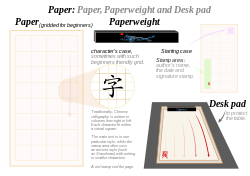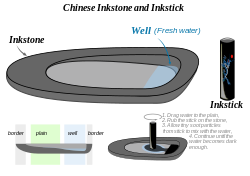Chinese calligraphy
Chinese calligraphy is calligraphy that is done in China. Chinese calligraphy is compared to painting, poetry, and music.[1]
| Chinese calligraphy | |||||||||||||||||||||||
|---|---|---|---|---|---|---|---|---|---|---|---|---|---|---|---|---|---|---|---|---|---|---|---|

| |||||||||||||||||||||||
| Chinese name | |||||||||||||||||||||||
| Traditional Chinese | 書法 | ||||||||||||||||||||||
| Simplified Chinese | 书法 | ||||||||||||||||||||||
| |||||||||||||||||||||||
| Korean name | |||||||||||||||||||||||
| Hanja | 書藝 | ||||||||||||||||||||||
| |||||||||||||||||||||||
| Japanese name | |||||||||||||||||||||||
| Kanji | 書道 | ||||||||||||||||||||||
| Hiragana | しょどう (modern) しよだう (historical) | ||||||||||||||||||||||
| |||||||||||||||||||||||
| Part of a series on |
| Calligraphy |
|---|
 |
In China, calligraphy is called shūfǎ (書法/书法). It means "way/method/law of writing". It is called shodō (書道) in Japan. It means "way of writing" in Japanese. It is called seoye (서예; 書藝) in Korea. It means "skill of writing" in Korean.[2]
Materials and tools
Four of the most important tools in Chinese calligraphy are called the Four Treasures of the Study. They are the ink brushes, the ink, the paper, and the inkstone. Many calligraphers also usually use water-droppers, paperweights.
Stroke order
Calligraphy usually follows a certain order when writing.
Chinese Calligraphy Media
Oracle bone fragment, Shang dynasty (ca. 1600–1046 BC)
Memorial to Yueyang Tower by Fan Zhongyan, Song dynasty
On Calligraphy by Mi Fu, Song dynasty
Poems of The four treasures in a scholar's study (Qing dynasty)
References
- ↑ Li, You-Sheng. A New Interpretation of Chinese Taoist Philosophy: An Anthropological/Psychological View.
- ↑ Wang Li; et al. (2000). 王力古漢語字典. Beijing: 中華書局. p. 1118. ISBN 7101012191.









